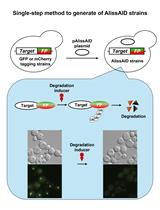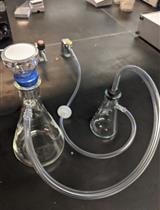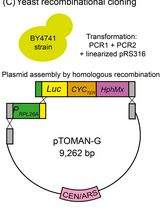- EN - English
- CN - 中文
A Rapid Induction Overexpression System for the Fission Yeast Schizosaccharomyces pombe
裂解酵母裂殖酵母的快速诱导过表达系统
发布: 2021年10月20日第11卷第20期 DOI: 10.21769/BioProtoc.4198 浏览次数: 2632
评审: Julie WeidnerLaia ArmengotAnu P. Minhas

相关实验方案

利用靶向GFP或mCherry的纳米抗体在出芽酵母中一步生成AlissAID条件性敲降菌株
Yoshitaka Ogawa [...] Takumi Kamura
2024年06月20日 2004 阅读
Abstract
The fission yeast Schizosaccharomyces pombe is an excellent genetically tractable model organism used in the study of conserved eukaryotic cellular biology. One genetic tool in the assessment of gene function is the in vivo overexpression of proteins. Existing overexpression tools have limitations of induction kinetics, dynamic range, and/or system-wide changes due to the induction conditions or inducer. Here, I describe the methodology for the use of a plasmid-based long non-coding RNA (lncRNA)-regulated overexpression system that is induced by the addition of thiamine. This system, termed the pTIN-system (thiamine inducible), utilizes the fast repression kinetics of the thiamine-regulated nmt1+ promoter integrated with the lncRNA regulated tgp1+ promoter. The advantages of the pTIN-system are rapid induction kinetics of gene expression, broad dynamic range, and tunable expression.
Keywords: Thiamine-induced (硫胺素诱导)Background
Overexpression is a useful tool to study gene function. In the fission yeast Schizosaccharomyces pombe, many such tools exist, but each system has some disadvantages, including slow induction kinetics, narrow dynamic range, induction-based growth arrest, stress and/or system-wide transcriptional changes, self-limiting gene expression, and requirement of strain construction (addressed in Garg, 2020). The thiamine-repressed nmt1+ promoter is the most popular regulatable system used in fission yeast (Forsburg, 1993). This promoter system has a fast rate of repression but takes 14-20 h to induce mRNA expression (Maundrell, 1990). To transcend the limits of existing systems, I had designed the pTIN-system (Garg, 2020). Here, the nmt1+ promoter directs synthesis of the nc-tgp1 lncRNA, which is 5’-adjacent to the tgp1+ promoter. The tgp1+ promoter in turn guides the synthesis of the gene of interest (GOI). In thiamine-starved conditions, lncRNA transcription interferes with the tgp1+ promoter and represses expression of the GOI. Inclusion of thiamine shuts off lncRNA synthesis and allows GOI expression. The pTIN-overexpression system has (i) rapid induction with maximal mRNA expression within an hour after the addition of thiamine, (ii) 60-fold dynamic range, and (iii) tunable expression by varying thiamine concentration in the medium (Garg, 2020). This protocol describes the utilization of the pTIN-system.
Materials and Reagents
Consumables
Test tubes (Fisherbrand, catalog number: 14-961-34, or equivalent)
Standard sterile serological pipettes (2, 5, 10, and 25 ml)
Micropipette tips (1,000-100 µl, 200-20 µl, 20-2 µl, and 2.0-0.1 µl)
100 × 15 mm Petri dishes (VWR, catalog number: 25384-088 or equivalent)
15 and 50 ml centrifuge tubes (Corning, catalog numbers: 430766 and 430291, respectively, or equivalent)
Medium and growth conditions
Standard pombe minimal glutamate (PMG) medium, pH 5.6, supplemented as necessary with 250 mg/L each of adenine, uracil, leucine, histidine, and lysine (Sabatinos and Forsburg, 2010). Bacto agar should be added at a final concentration of 2% (w/v) for preparation of solid agar medium. Leu-PMG medium has all supplements mentioned except leucine. Add thiamine as specified in the methods. Thiamine must be added after cooling the media to 45-50°C after autoclaving for preparation of PMG agar medium with thiamine.
The base pTIN-system vectors, pTIN and pTIN7m, are available at: https://www.addgene.org/Stewart_Shuman.
pTIN ID#162885
pTIN7m ID#162886
Your GOI can be cloned into and overexpressed from these vectors.
Adenine (Sigma, catalog number: A2786)
Uracil (catalog number: U0750)
Leucine (Fisher, catalog number: BP385-100)
Histidine (Sigma, catalog number: H5659)
Lysine (Fisher, catalog number: BP386-100)
Bacto agar (BD, catalog number: 214010)
Thiamine hydrochloride (Sigma, catalog number: T1270)
Bacto agar (BD, catalog number: 214010)
Yeast competent cells and transformation
Tris base (Fisher, catalog number: BP152)
EDTA (Sigma, catalog number: E5134)
Lithium acetate (LiOAc) (Sigma, catalog number: L4158)
PEG 3350 (Sigma, catalog number: P4338)
Glycerol (Fisher, catalog number: BP229)
Salmon sperm DNA (ssDNA) (Sigma, catalog number: D1626)
LiOAc-mix (see Recipes)
PEG-mix (see Recipes)
50% Glycerol/LiOAc-mix (see Recipes)
Salmon sperm DNA (ssDNA) solution (see Recipes)
2,000× Thiamine hydrochloride (see Recipes)
Equipment
Incubator shaker (New Brunswick Innova 44 or equivalent)
Micropipettes (1,000-100 µl, 200-20 µl, 20-2 µl, and 2.0-0.1 µl)
Standard glass Erlenmeyer flasks (volume of culture should not exceed half the volume of the flask)
Incubators (Nuaire IR autoflow or equivalent)
Test tube roller (New Brunswick, TC-7 with 25 mm test tube holder or equivalent)
Microcentrifuge (Eppendorf 5425 or equivalent)
Microcentrifuge tubes (Crystalgen, catalog number: L-2052 or equivalent)
Glass beads (Fisher Scientific, catalog number: 11-312C or equivalent)
Cooling centrifuge (Thermo Scientific Sorvall BP8 with HAEMAFlex 6 swinging bucket rotor or equivalent)
Centrifuge bottles (Thermo Scientific, catalog number: 3120-0250 or equivalent)
Procedure
文章信息
版权信息
© 2021 The Authors; exclusive licensee Bio-protocol LLC.
如何引用
Garg, A. (2021). A Rapid Induction Overexpression System for the Fission Yeast Schizosaccharomyces pombe. Bio-protocol 11(20): e4198. DOI: 10.21769/BioProtoc.4198.
分类
微生物学 > 微生物遗传学 > 质粒
微生物学 > 微生物遗传学 > 基因表达
分子生物学 > DNA > 染色体外DNA
您对这篇实验方法有问题吗?
在此处发布您的问题,我们将邀请本文作者来回答。同时,我们会将您的问题发布到Bio-protocol Exchange,以便寻求社区成员的帮助。
Share
Bluesky
X
Copy link











